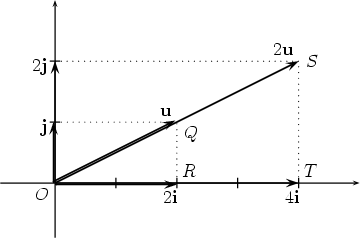 |
||||||||||||||||||||||||||||||||||||||||||
|
7. Cartesian coordinates in three dimensions
|
||||||||||||||||||||||||||||||||||||||||||
|
|
||||||||||||||||||||||||||||||||||||||||||
|
If a vector is expressed in Cartesian form, then it’s easy to calculate any scalar multiple of that vector in Cartesian form. The general rule is that given any vector v = xi + yj + zk and any scalar a, then 
For example, if v = 2i + j - k, then -4v = -8i - 4j + 4k. The same formula applies in two dimensions. The vector v = xi + yj can be thought of as v = xi + yj + 0k. Then if a is any scalar, 
Thus if u = 2i + j then 2u = 4i + 2j, as illustrated in the following picture.

|
|||||||||||||||||||||||||||||||||||||||||
| Feedback |
|
|||||||||||||||||||||||||||||||||||||||||
© 2002-09 The University of Sydney. Last updated: 09 November 2009
ABN: 15 211 513 464. CRICOS number: 00026A. Phone: +61 2 9351 2222.
Authorised by: Head, School of Mathematics and Statistics.
Contact the University | Disclaimer | Privacy | Accessibility